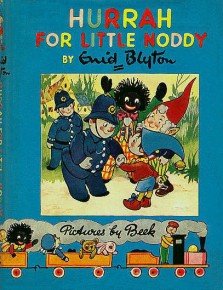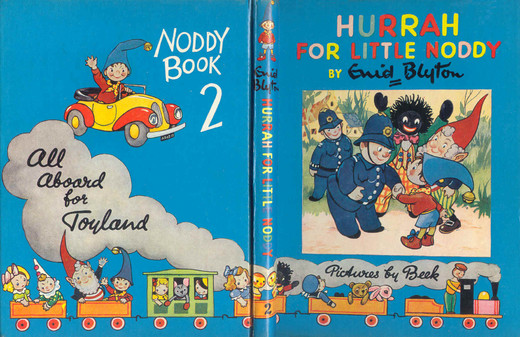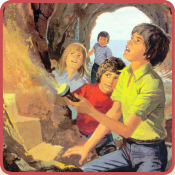
Hurrah For Little Noddy

Book Details...
First edition: 1950
Publisher: Sampson Low
Illustrator: Harmsen Van der Beek
Category: Noddy
Genre: Fantasy
Type: Novels/Novelettes
Publisher: Sampson Low
Illustrator: Harmsen Van der Beek
Category: Noddy
Genre: Fantasy
Type: Novels/Novelettes
On This Page...
Reprints
1. 1986 Macdonald Purnell, illustrations and cover by Edgar Hodges
2. 2008 HarperCollins, illustrations and cover by Harmsen Van der Beek
2. 2008 HarperCollins, illustrations and cover by Harmsen Van der Beek

Cover from the 1st edition, illustrated by Harmsen Van der Beek

Frontis from the 1st edition, illustrated by Harmsen Van der Beek



Front and back flaps from the dustwrapper of the 1st edition
and front flap from a later reprint

Title page from the 1st edition
Fisher — Who's Who in Children's Literature? ©1975
And of course there have been critics who have detected murky undertones in Noddy’s relationship with Big Ears: "If you can squeeze into my tiny bed, you can sleep with me tonight," said Big-Ears ... They squashed into Big-Ears' tiny, soft bed, put their arms around one another to stop themselves from rolling out, and fell fast asleep.
Mullan — The Enid Blyton Story ©1987
A synopsis: — Noddy searches for work, finds it then accidentally discovers that the cars housed in a garage where he was briefly employed have been stolen. He and his pal Big-Ears are instrumental in the recovery of the vehicles and there is a very happy ending. For a far more detailed account minus the conversations and the many bright pictures and lots of other details which add positively to the story, read below:
Noddy is established in his little house and the milkman calling round to introduce himself to his new customer becomes a little confused at the way Noddy's head bobs up and down. It's difficult to discern as to how many bottles of milk are required because when Noddy is asked if he wants one bottle or two, he nods each time. However, once the reason for this is explained and Noddy has also let on that he has no money, the milkman very kindly says he will give him free milk when he calls provided he can tap his head to watch it go up and down.
That's the milk taken care of but Noddy needs cash for other things such as some furniture. All he has at present is a chair but that was lent to him by the bear next door — Mr. Tubby. Noddy desires employment and he wants it immediately. Mr. Tubby's wife suggests a place and Noddy sets off to find Four-Chimney House where there's a bit of a spring-clean going on. Noddy's asked if he could sweep the chimneys so he has a go and manages quite well then he scrubs the kitchen floor and later, when he's taking a pile of old furniture out to the back garden to be put on the bonfire, he realises that with a little repairing he could use it for his house. He asks permission to keep what he wants and it is granted so he's off home after work taking with him an old bed, a broken chair, a cracked table and a holey carpet. He busies himself that evening by doing a spot of mending and his house certainly looks much more comfortable when everything's finished. He also has his wages and being a good little chap he puts aside some of his money to pay back Big-Ears who had lent him cash for clothing and a few essentials when he first came to Toy Village. He now needs work again so he visits the local garage which Mr. Golly owns and is given the task of cleaning the customers' cars. This lasts him a week and then he has to finish up because the man who usually cleans the vehicles has come back from his holiday or whatever.
The plot now begins because Noddy, having left his hat there when he departed, returns to the garage in the evening and comes across something strange. The door is open and all the cars are being driven away by a band of goblins! You can see it happening in the picture where the cars are passing a very toy-like tree which is only natural because the setting is Toy-Village then over the bridge they go and into the distance. Noddy is terribly surprised and he feels that he must do something about this so, locating an old and rather derelict car somewhere in the garage, he jumps into it and sets off in pursuit. He's never driven before but knows how to steer and despite some wobbling he manages to keep on the road and roughly at 60 m.p.h. to keep up with the goblins (60 m.p.h. would be about 100 Kilometres Per Hour).
As stated, the car is old and therefore not necessarily reliable which it demonstrates when a wheel falls off making it spin round and crash into a tree. Noddy flies out — still holding the steering wheel and he land s in a bush with all the breath knocked out of him. Dazed and shaken and miles out in the country with only the moonlight to see by, Noddy is in a jam but suddenly a figure carrying a lantern approaches him? What a stroke of luck — it's none other than Big-Ears, Noddy's best friend. He happens to live nearby so he invites the little man to stay the night in his house and a very relieved Noddy follows him to a big toadstool with a door and a tiny stairway. Big-Ears knows where the goblins have gone — they live in Goblin Village so that matter can wait till the morning. He produces hot cocoa and biscuits (one each) and they partake in a very cosy little supper and after that it's time for bed and as there's only one bed in the house, Noddy has to sleep with Big-Ears and it's certainly a bit of a squeeze because the brownie is not all that small.
Next morning Big-Ears says he'd better be the one to go and scout around Goblin Village because Noddy, being a toy, might cause suspicion. He does so and learns a lot — so much in fact that he shoots off to collect Noddy and they race to Toy Village on Big-Ears' bike to inform the police. Noddy is rather apprehensive as to what will happen over the matter of his hijacking one of Mr. Golly's cars and busting it up As can be imagined there's much consternation in the village when the garage is found empty of all its vehicles and to make matters worse, Noddy's hat has been found in the vicinity which seems to establish his guilt. Noddy and Big-Ears arrive and sure enough, poor Noddy is marched off to prison before any explanations can be made. There he is — sitting on a bench with his chin in his hands and prison bars above him. What will happen now?
Big-Ears makes things happen and fast. Originally swallowed up by the angry crowd he has now reached the police station and is hammering on the door in a sizeable temper. He begins explaining but then refuses to tell them where the stolen cars are because of the villagers' treatment of his friend. He immediately receives an assurance from Mr. Golly that he doesn't mind about the old car being smashed up — he just wants the other vehicles back. Big-Ears drives a hard bargain and suggests the bestowing of a reward on Noddy for his diligence in taking action when he discovered the goblins making off with the cars.
Mr. Golly is ready to agree to anything and after Noddy has been sprung from jail and has given details of just where the cars are hidden (knowledge which he had earlier obtained from Big-Ears) there's an invasion of Goblin Village by an army made up of the stolen cars' owners plus some policemen and Noddy with Big-Ears of course. The chief goblin is reticent to reveal much about anything but the cars are found all right and then each goblin is fined one penny by the policemen to teach them not to steal toy cars ever again. All the car-owners grab their vehicles and they're off back to Toy Village. What a happy ending and there's more to come.
Not only is there a feast all ready in the market-place for the two heroes, but there's also the presentation to Noddy of an icon that is recognized all round the world — a little red and yellow car! Noddy can hardly believe his eyes. What a magnificent gesture. "Is it really for me?" The feast begins and is enjoyed by one and all, and then comes the happiest moment of Noddy's day — he gets into his little car and with Big-Ears beside him he drives all round the market-place. Could anything else happen to gild this day? Well ... Noddy does have a WONDERFUL idea!
"I'll be a taxi-driver!"
Naturally, there are plenty of pictures — in fact, one on each page with lots of full-leaf illustrations.
Reviews that deal with the original books could be a little confusing especially in Noddy's case because so many changes have been made due to the elimination and/or substitution of characters. To gain the full measure of Noddy — especially in an assessment vein, it would be a good idea to look around for the editions that were printed before the 'Changes' or 'Desecrations' or 'Censoring' took place (I wonder if they took out that judge in the first book who likes dressing up as a woman)! Possibly copies that came out before 1990 or so should suffice and these can be found on the auction sites. An enquiry would tell you whether the coveted book features the original characters.
Why do kids like Noddy? A case could be made for the fact that, in a way, he's very similar to your typical small child — a little spoilt, rather selfish, he bursts into tears every now and again and he loses his temper quite badly at times. He has bouts of enthusiasm and gets into trouble occasionally which calls for a punishment of some kind and furthermore, another attraction could be that although Noddy gives the impression of being a little boy, he's actually a Grown-Up. He has his own car and house and he works to earn money so this gives him an adult's independence. "What a great life he has. He can do what he likes and yet he acts just like us. Noddy Rules O.K!"
Many adults think that Noddy Rules OK as well and perhaps this could be attributed to the 'Nostalgia' aspect. The books we read when we were small can hold a great influence over us in later years. I'm sure I would have related really well to the Beatrix Potter books had I been familiar with them in early childhood but I wasn't introduced to those classics and I didn't have Noddy when I was very young either so I related to Christopher Robin and tales like The Adventures of the Wishing Chair and The Folk of the Faraway Tree plus my very earliest school books which are well remembered and re-read every now and again. One book can be well-loved — but a series of books is better because they can provide a longer period of withdrawal from the complexities of the present-time and allow the reader to enjoy living for a while in a safe and predictable world of familiar characters and surroundings. I didn't get all that much out of Noddy when I first read about him because I wasn't of the target age but the pictures are colourful and the books are easy to read and one must remember that the little nodding man exists primarily for children of a younger age — three years, four years, five years or perhaps a little older.
There's been an awful lot of comment by Enid Blyton detractors about the fact that Noddy and Big-Ears slept together! Why shouldn't they? There was only one bed. People often sleep together and if you look at movies that feature those immortal clowns — Stan Laurel and Oliver Hardy, you'll see them bedding down together in that hilarious short Brats and again in Berth Marks and also in A Chump at Oxford amongst others. Shall we warn our children not to watch Laurel and Hardy movies in case they see something that shouldn't be seen? What about females sleeping together? I can't think of a specific Enid Blyton book where that happens but I'm sure George and Anne of the Famous Five have done so when camping or trapped in caves — in fact I think all those kids have curled up together in some of their exotic locations. Same goes for the Mannering lot — The Valley of Adventure being just one example. Grown men often slept together in days gone by especially when, like Laurel and Hardy, they were 'mates' of an itinerant nature — roaming from boarding house to boarding house and usually possessing very little money. One double bed was sufficient so perhaps we might assume that the criticism concerning Noddy is once again an attempt to slur the little man and his friend by intimating that their behaviour is a little odd in the hope that parents will think twice when dithering over what book to buy for their child's birthday. Noddy and Big-Ears, in truth, were men so perhaps the moralists thought that as the years moved past the Fifties into the Eighties and the Nineties, grown-ups of the same gender weren't meant to sleep together — in children's books at least. However, I'm sure that Noddy and Big-Ears in their toy identities were seen more as kids rather than mature adults but, all in all, it goes to show what a load of rubbish all the condemnations are! The 'Murky Undertones' are thought up by adults. Think of how many 'Murky Undertones' there are in adult reading matter! Why doesn't a child pick through an adult book, note any so-called 'Murky Undertones', and then suggest that the author is incompetent and the book should be taken off the shelves? It's all very one-sided isn't it? Do adults really believe that murkiness exists in Hurrah for little Noddy? I cannot imagine they do. Why then do people warp the innocent situations in Noddy books? Possibly they have an axe to grind because Enid Blyton is more successful than all of her critics put together. Most authors have probably slogged away for years at writing school or wherever they go, got their qualifications, and then discovered that EB has wiped the floor with them by her use of simple language, natural talent, and an inherent ability to communicate with youngsters. Her books have flooded the market which means, of course, that they invite comment. That's natural but why is there so much criticism? A large company receives criticism usually because their costs and services affect lives. EB didn't affect peoples' lives like that — she was simply an author, a 'children's' author and perhaps this together with a related innocence made her a Sitting Duck. If you can't sell more books than a children's author, no matter how sophisticated and educated and qualified you are, then one (childish) way of expressing your frustration is to criticize and read things into the Blyton stories in the hope that teachers and parents will deny them to all young people. I think we all read things into Blyton stories and laugh about what we come up with and, because the author is so well known, she also invites satire — lots of it, which is all good fun as far as I can see. To read things into the stories with the purpose of condemning them is another side of the coin and an analysis has to be made so that we can understand the attitudes of the E.B Detractors. Almost anything can be described 'basically' in one or two words and a representative exercise in this would be to find a word that sums up the purpose of all human existence. Perhaps a couple of examples could be 'Procreate' or 'Survive'. Now, how in a word or two, do we sum up the attitudes of the critics who have attacked Enid Blyton over the years? After a bout of intense meditation and analysis of the emotional propensities involving the human psyche and then conducting a theoretical evaluation regarding characteristics associated with the behavioural proclivities which can be attributed to mankind as a 'whole' I came up with two appropriate words which I will put down in the right order so that the context is understood. Number One = 'Sour'. Number Two = 'Grapes'. These illustrations are hidden by default to ensure faster browsing. Loading the illustrations is recommended for high-speed internet users only.








